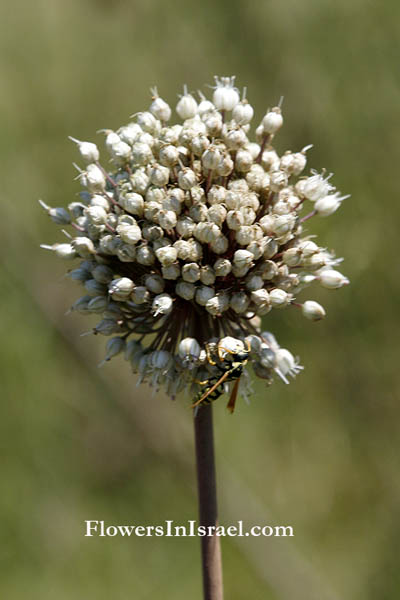Elephant garlic, Levant Garlic, Wild Leek, Kurrat,
Hebrew: שום גבוה, Arabic: ثوم بري
| Scientific name: | Allium ampeloprasum L. | |
| Synonym name: | Allium porrum L. | |
| Common name: | Great-Headed Garlic, Elephant garlic, Levant Garlic, Wild Leek | |
| Hebrew name: | שום גבוה | |
| Arabic name: | ثوم بري | |
| Family: | Amaryllidaceae, נרקיסיים | |
| Subfamily: | Allioideae (formerly treated as a separate family, Alliaceae) | |
| Tribe: | Allieae (comprises a single genus, Allium) | |
| Genus: | Allium, שום |

|
| Life form: | Geophyte | |
| Stems: | Pseudo-stem, a false stem made of the rolled bases of leaves | |
| Leaves: | Alternate, rosette, entire; 5-40mm wide, linear, flat | |
| Inflorescence: | Umbel 5-9cm in diameter, globose, usually dense | |
| Flowers: | purple, pedicels 10-60mm | |
| Fruits / pods: | Capsule 4mm | |
| Flowering Period: | April, May | |
| Habitat: | Shrub-steppes, Desert | |
| Distribution: | Mediterranean Woodlands and Shrublands, Semi-steppe shrublands, Shrub-steppes, Deserts and extreme deserts, Montane vegetation of Mt. Hermon | |
| Chorotype: | Med - Irano-Turanian | |
| Summer shedding: | Ephemeral | |
| Protected Flower, צמח מוגן: | yes |
|
Derivation of the botanical name: Allium, onion, chive and garlic. From the classical Latin name for garlic. ampeloprasum, ampelos, αμπελοϛ, "a vine", Clematis maritima; o connective vowel in botanical Latin; prason, πρασον, "leek"; um, Latinizing nounal suffix. A wild leek found in Greek vineyards. The Hebrew word: שום, shum, Akkadian: sumu; Aramaic: Thomas; שום, אכדית: sumu; ארמית: תומא
It is probably more closely related to the leek than to ordinary garlic. The bulbs are very large and can weigh over a pound. A single clove of elephant garlic can be as large as a whole bulb of ordinary garlic. Allium ampeloprasum sensu lato is a wide complex of wild ecotypes and cultivated plants. More or less bulbous leek was well known and cultivated by ancient Egyptians, Greeks and Romans. Allium is one of the most ancient of man's herbs. The oldest recorded literature from the Sumerians is dated at 2600-2100 BCE. It was part of the staple diet of the Egyptian pyramid builders. Several cloves of garlic were found in the tomb of Tutankhamun (c.1370-52 BCE). Garlic was also mentioned in the Bible, during the time of the exodus (Numbers 11:5-6 (c. 550-400 BCE)), and in the Talmud. Its historical or traditional use (may or may not be supported by scientific studies) has been mentioned by Hippocrates, Galen, Pliny the Elder, and Dioscorides for many conditions, including parasites, respiratory problems, poor digestion, and low energy.
Bible resources:
|